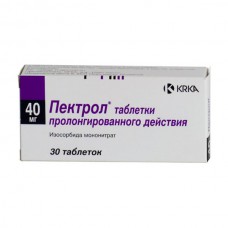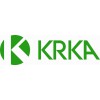Expiration date: 05/2026
The composition and form of issue:
Extended-release tablets, 1 tablet contains:
isosorbide-5-Mononitrate 40 or 60 mg
excipients: hypromellose Carnauba wax stearic acid purified lactose monohydrate magnesium stearate silicon dioxide purified talc titanium dioxide macrogol 4000 dye iron oxide red
blistere in 10 PCs., in box 3 blister.
Description pharmaceutical form:
Pills 40 mg: round, slightly biconvex tablets, film-coated cream colour, with the inscription "IM 40" on one side, with possible inclusions.
Pills 60 mg: oval, slightly biconvex tablets, film-coated cream colour, with a notch on both sides and marked "60" on one side, with possible inclusions.
Pharmacokinetics:
After intake of isosorbide Mononitrate is rapidly and completely absorbed from the gastrointestinal tract. The absolute bioavailability is approximately 100%, since no effect "first passage" through the liver.
The release of isosorbide Mononitrate tablets do not depend on food intake, motility or pH in the lumen of the intestine.
Isosorbide Mononitrate is distributed in the liquid environment of the organism, and only 5% is associated with blood plasma proteins. The therapeutic concentration of 100 ng/ml is achieved 30 minutes after ingestion.
Isosorbide Mononitrate geneticaly and is metabolized by conjugation with glucuronic acid. An inactive metabolite is excreted via the kidneys. Kidney Cl — 115 ml/min.
T1/2 — from 4 to 10 h In hepatic and renal insufficiency, the pharmacokinetics of isosorbide Mononitrate does not change significantly.
Description pharmacological action:
Peripheral vasodilator with a predominant effect on venous vessels. Stimulates the vascular endothelium to nitric oxide (endothelial relaxing factor), causing the activation of intracellular called guanylate cyclase, resulting in an increase in cGMP (mediator of vasodilation). Vasodilation decreases venous return to the heart (preload), reducing the load on the heart, which reduces the need of myocardium in oxygen. Deleterule the effect of nitrates on arteries and arterioles, reduces peripheral vascular resistance (afterload). Has coronary dilator action. Reduces blood flow to the right atrium, reduces the pressure in the pulmonary circulation and regression of symptoms oteke light. Promotes redistribution of coronary blood flow in the area with reduced blood supply. Increases tolerance to physical load in patients with ischemic heart disease, angina. Dilates blood vessels of the brain, the Dura mater, which may be accompanied by headache. Inhibits platelet aggregation, reduces thromboxane synthesis vnutritrombozitarnyi. As with other nitrates, develops cross-tolerance. After a cancellation (interruption of treatment) - sensitivity is quickly restored. Antianginal effect occurs within 30-40 minutes after ingestion and lasts up to 8-10 hours
Indications:
- prevention of angina in patients with coronary artery disease
- chronic heart failure (in combination therapy).
Contraindications:
- hypersensitivity to nitrates or other components of the drug
- hypotension and hypovolemia (SBP <100 mm Hg. art., DBP <60 mm Hg. article, Central venous pressure <4-5 mm Hg. article)
- acute heart failure
- shock
- circulatory collapse
- left ventricular failure with low-end dud
- acute myocardial infarction (severe hypotension)
- cardiac tamponade
- toxic pulmonary edema
- diseases accompanied by increased intracranial pressure (including hemorrhagic stroke, TBI)
- breastfeeding
- the age of 18 years (efficacy and safety not established).
With caution:
- mitral valve prolapse
- aortic and/or mitral stenosis
- tendency to orthostatic disorders of vascular regulation
- constrictive pericarditis
- old age
- severe anemia
- thyrotoxicosis
- hypertrophic cardiomyopathy (probably strokes)
- renal insufficiency
- hepatic failure (risk of methemohlobinemia).
Side effects:
From the side of cardiovascular system: "nitrate" headache, dizziness, transient hyperemia of the skin, sensation of heat, tachycardia, marked reduction in blood pressure in rare cases — increased angina (paradoxical reaction), orthostatic collapse.
Gastrointestinal: nausea, vomiting, may cause slight burning sensation of the tongue, dry mouth.
CNS: stiffness, drowsiness, blurred vision, decreased ability to rapid mental and motor reactions (especially at the beginning of treatment) in rare cases, ischemia of the brain.
Allergic reactions: skin rash, in some cases, — exfoliative dermatitis.
Other: the development of tolerance (including cross-to other nitrates).
Drug interactions:
Increases the concentration of dihydroergotamine in plasma.
Barbiturates accelerate the biotransformation and reduce the concentration of isosorbide Mononitrate in the blood.
When used together with antihypertensive drugs, vasodilators, antipsychotic means (neuroleptics), tricyclic antidepressants, procainamide, ethanol, quinidine, beta-blockers, CCB, and sildenafilom dihydroergotamine may increase the hypotensive effect.
With the combination of amiodarone, propranolol, CCB (verapamil, nifedipine and others), acetylsalicylic acid and isosorbide Mononitrate antianginal may increase the effect.
Under the influence of beta-agonists, alpha-adrenergic blocking agents (dihydroergotamine, etc.) may reduce the severity of antianginal effect (tachycardia, excessive decrease in blood pressure).
With the combined use of m-anticholinergics (atropine, etc.) increases the likelihood of raising intraocular pressure.
Adsorbents, binders and enveloping means reduce the absorption of isosorbide Mononitrate in the digestive tract.
Method of application and dose:
Inside, after eating, and swallowing whole with a glass of water. The usual initial dose of 40 mg 1 time per day (in the morning). If necessary, the dose may be increased up to 60 mg per day. In the case of nocturnal attacks of angina pill should be taken in the evening. The dose can be increased to 60 mg 1 time per day or 80 mg (40 mg 2 times a day).
The treatment of chronic heart failure started in the hospital, where selected appropriate maintenance dose based on clinical effect and side effects.
For both indications, patients should take 1 tab. (40 or 60 mg), 1 time per day or 1 tab. (40 mg) 2 times a day (the first pill in the morning and the second approximately 7 hours). The interval between doses of the drug in the evening and receiving the next dose in the morning should be at least 12 h
Overdose:
Symptoms: headache, dizziness, palpitations, hyperthermia, skin flushing, sweating, nausea, vomiting, diarrhea, methemoglobinemia (cyanosis, anoxia), hyperpnoea, dyspnoea, bradycardia, convulsions, visual disturbances, increased intracranial pressure, collapse, fainting, paralysis, coma.
Treatment: gastric lavage, if methemohlobinemia — inside or/in ascorbic acid (1 g), 1% solution of methylene blue (1-2 mg/kg). Symptomatic therapy in severe arterial hypotension — I/phenylephrine (mezaton) epinephrine and related compounds are ineffective.
Special instructions:
Pektrol not intended for relief of angina attack.
Proper use of isosorbide Mononitrate guarantees the presence of a low concentration of nitrate, which is necessary to prevent the development of nitrate tolerance. As with all nitrates, it is important to strictly follow the instructions for dosage of Pektrol and to comply with the 12-hour interval between doses. In this case, achieving a low concentration (<100 ng/l), and maintained therapeutic effect.
It is necessary to avoid abrupt discontinuation of the drug and reduce the dose gradually.
During therapy required monitoring of blood pressure and heart rate.
When transferring patients receiving isosorbide dinitrate to isosorbide Mononitrate, the total daily dose should be calculated in advance. It is known that 10 mg of the match Mononitrate 20 mg isosorbide dinitrate.
Possible decreased ability to rapid mental and motor reactions, so be careful to drive vehicles and engage in potentially hazardous activities during the period of drug therapy.



